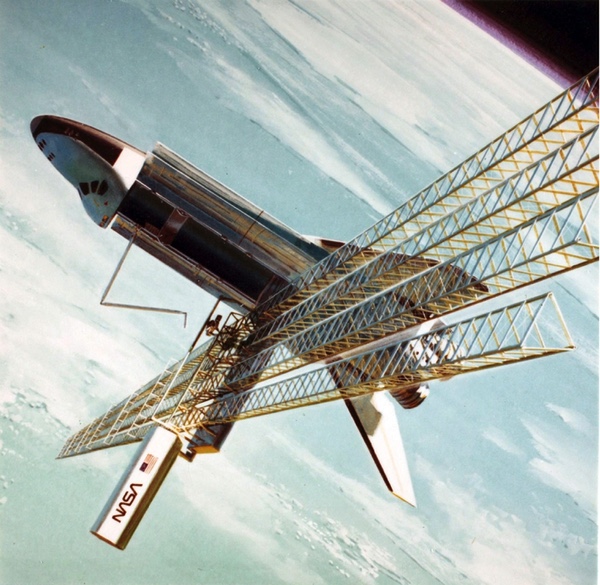Beams in the sky, part 2: General Dynamics, Grumman, and composite materialsby Dwayne Day
|
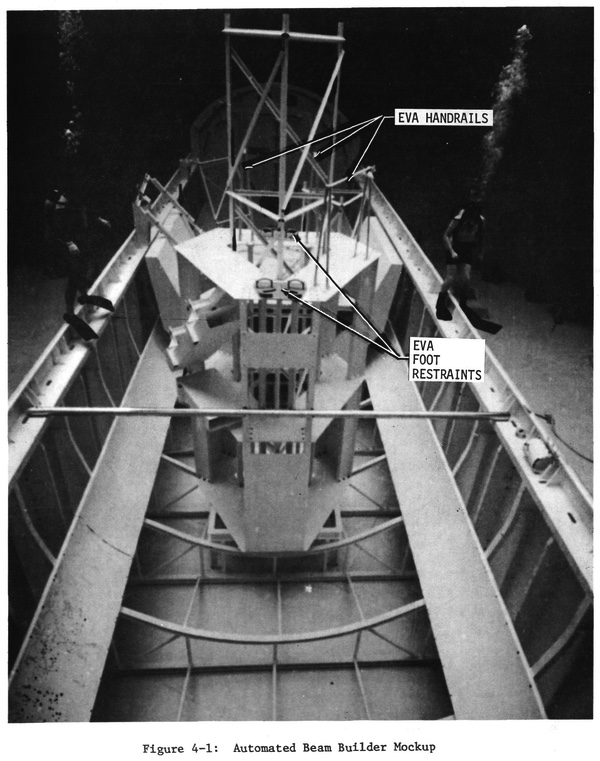 NASA conducted underwater tests at Marshall Space Flight Center in the late 1970s/early 1980s using aluminum beams manufactured by Grumman. (credit: NASA) |
While Grumman was studying an aluminum beam building machine, another aerospace company, General Dynamics, was studying the use of other materials for beams.
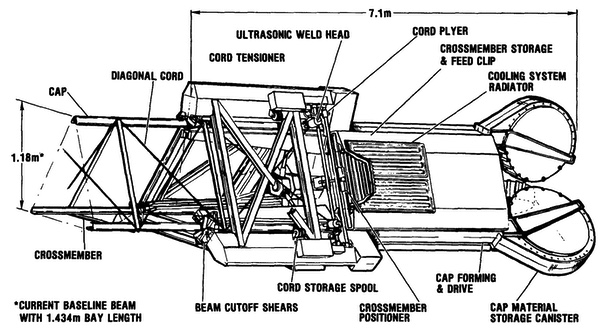 General Dynamics performed the Space Construction Automated Fabrication Experiment Definition Study (SCAFEDS) looking at using composite materials to construct beams/trusses in space. The General Dynamics proposal shared similarities with Grumman's design which welded aluminum beams. (credit: General Dynamics) |
General Dynamic’s SCAFEDS
General Dynamics in the late 1970s conducted a Space Construction Automated Fabricated Experiment Definition Study (SCAFEDS). Rather than aluminum alloy, SCAFEDS used a laminated composite strip material for caps and cross-members. Some of the material was resin-impregnated for ease of manufacturing and also had an anti-radiation coating. The diagonal beams were preloaded, and the materials were ultrasonic spotwelded.
General Dynamics evaluated four different configuration options before deciding on a rolltrusion forming process. A cap forming and drive section would contain all the elements to continuously process flat strips of thermoplastic material into the baseline cap configuration. Approximately 918 meters of material would be coiled in a roll retained in the storage canister.
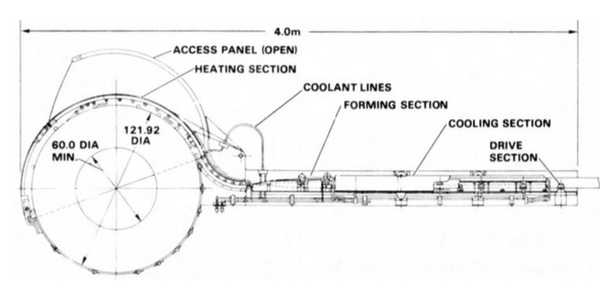 The Space Construction Automated Fabrication Experiment Definition machine would use composite materials in rolls that would have to be heated and shaped before being welded to cross trusses. (credit: General Dynamics) |
SCAFEDS would use a heating section with an internal passageway and continuous heating elements. The heated material would then pass to the rolltrusion forming section entrance. Inside the rolltrusion forming section would be strip heaters to preheat cool material during machine start-up. The material would then pass to a cooling section. Cross members would be fed into the machine and attached to the beams via spotwelding. At the end of the process a beam cutoff mechanism would sever each cap and cord member to separate a completed beam from the beam builder.
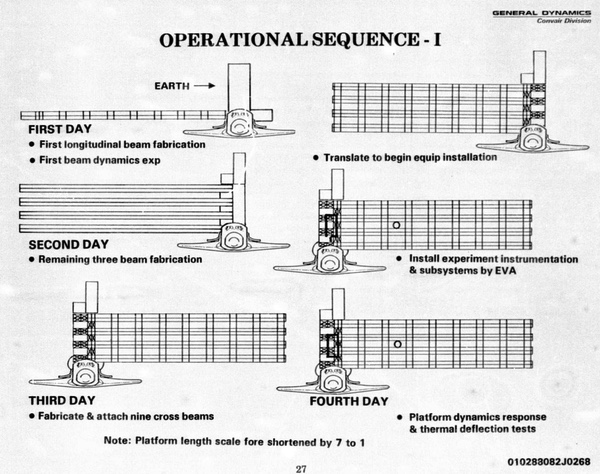 The General Dynamics SCAFED study completed in 1978 included a detailed outline of how the beam construction would be conducted in orbit. (credit: General Dynamics) |
Although there is limited information available on SCAFEDS, the use of laminated composite materials in space was a new technology. Composites are less predictable than metals, both in manufacture and use. The SCAFEDS approach certainly would have required careful testing.
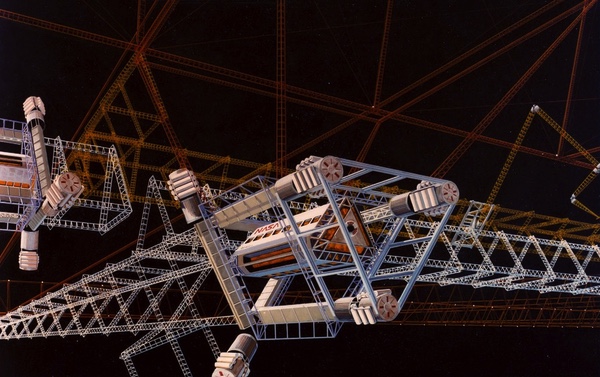 In the early 1970s, NASA and aerospace companies began studying the construction of large structures in space such as solar power satellites. Beams/trusses were a major component of those structures, leading to studies of how to make them in orbit using prepared materials such as rolled aluminum. (credit: NASA) |
Grumman and composites
Grumman also began studying composite materials while finishing development work on the aluminum beam builder. Grumman engineers studied what would be required to modify the existing machine to produce composite beams. In mid-1977, they began a “brute force” approach trying to roll form a graphite/polyethersulfone laminate using the tooling developed for the aluminum beam system (apparently not the full-test vehicle that had been delivered to NASA, but similar tooling.) The results were “disastrous, burnt toast,” according to a summary. This taught the team that they needed to look at lower temperatures as well as different materials.
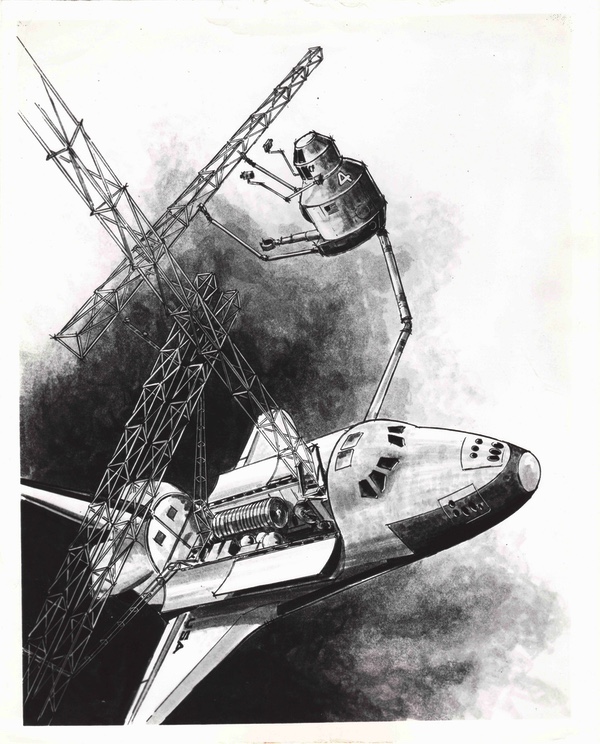 Grumman built an engineering demo capable of creating aluminum beams. The company also evaluated using composite materials for the beams. This Grumman illustration shows the possible assembly of the structures in space. (credit: Grumman Aerospace) |
The Grumman team decided to work with a graphite/acrylic material that had a lower forming temperature and a broader working temperature range. This provided sufficient experience for them to begin looking at different materials and to ask for funding “to design and build a composite structural component forming process development tool, since we had been tying up a piece of production machinery with our experiments,” according to one of the engineers. Once they had their new equipment, they returned to using graphite/polyethersulfone, with acceptable results. They tested other materials, focusing on thermoplastics, and eventually settled on a woven graphite/acrylic.
According to a Grumman engineer, the composite materials offered superior performance to aluminum and could last up to 40 years in orbit. But further testing was required, including the development of a flight qualified system. That did not occur. NASA apparently did not fund any further automated beam builder studies to follow this initial work.
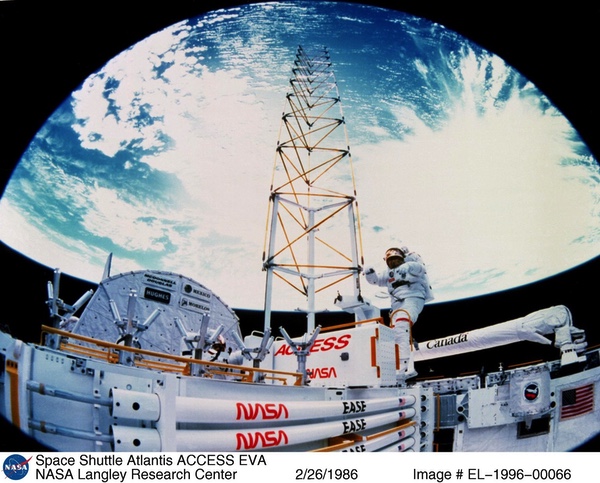 On space shuttle Atlantis in late 1985, the EASE (Experimental Assembly of Structures in EVA) and ACCESS (Assembly Concept for Construction of Erectable Space Structures) experiments demonstrated the first construction of large structures in weightlessness. (credit: NASA) |
Prefab
Unlike Grumman, General Dynamics did not build a full-scale ground demonstration model. By the early 1980s, NASA discontinued the space manufacturing tests and the agency began focusing more on pre-manufactured structures that would be carried into space in the shuttle’s payload bay.
On November 29 and December 1, 1985, astronauts on space shuttle Atlantis during mission STS-61B conducted the EASE (Experimental Assembly of Structures in EVA) and ACCESS (Assembly Concept for Construction of Erectable Space Structures) experiments in Earth orbit. These experiments were the first construction of large structures in weightlessness. ACCESS was developed by the NASA Langley Research Center, Hampton, Virginia and EASE was a project involving the NASA Marshall Space Flight Center in Huntsville, Alabama, and the Massachusetts Institute of Technology in Cambridge, Massachusetts. The experiments included the assembly of a large truss section.
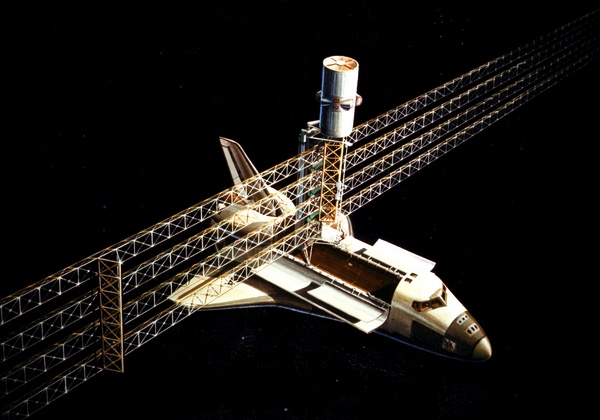 A 1978 illustration from NASA Langley showing the Space Shuttle assembling a large space structure using a generic beam builder machine. This technology was not actively pursued by NASA after the 1970s. (credit: NASA) |
A disadvantage of manufacturing structures in space is that equipment such as power and data cables must be attached to them and inspected. As aerospace engineers concluded over time, it was better to integrate and inspect equipment, including electronics, on the ground rather than in orbit. This was a problem for the 1960s Apollo “wet workshop” design that eventually became the “dry” Skylab, and was also a concern for proposed inflatable spacecraft in the 2000s. Eventually, when NASA began construction of the International Space Station in the late 1990s, it used prefabricated structures that already had major systems attached. In-space manufacturing was not part of the assembly plan. The space station did not require many large trusses, and the necessary ones could be outfitted with wiring and attached equipment that was integrated and pre-tested on the ground for greater reliability.
In recent years, NASA has periodically shown some interest in in-space manufacturing, including the construction of large structures. In-space assembly and manufacturing—now referred to as ISAM—periodically receives attention and funding from NASA and private industry. However, without a clearly defined requirement, the agency has not pursued much of this technology into the flight test stage.
Sources
E.O. Adams and C.N. Irvine, “MSFC Evaluation of the Space Fabrication Demonstration System (Beam Builder),” NASA Technical Memorandum TM-82440, George C. Marshall Space Flight Center, Marshall Space Flight Center, Alabama, September 1981.
Walter K. Muench, “Automated Beam Builder Update,” Space Solar Power Review, Vol. 1, pp. 299-316, 1980.
Space Construction Automated Fabrication Experiment Definition Study (SCAFEDS). Volume 1, Executive Summary, and Volume 2: Study results, General Dynamics, May, 1978.
Space Construction Automated Fabrication Experiment Definition Study (SCAFEDS). Part 2, Final Briefing, General Dynamics, February 3, 1978.
John G. Bodle, “Development of a Beam Builder for Automatic Fabrication of Large Composite Space Structures,” General Dynamics, NASA. Johnson Space Center The 13th Aerospace Mechanisms Symposium, January 1979.
Note: we are now moderating comments. There will be a delay in posting comments and no guarantee that all submitted comments will be posted.
